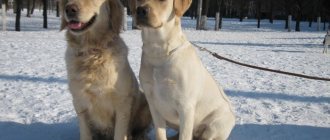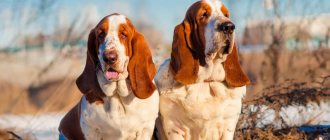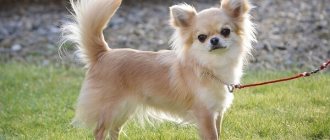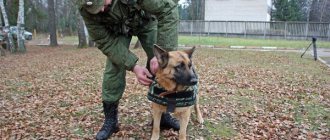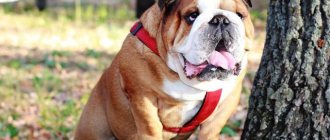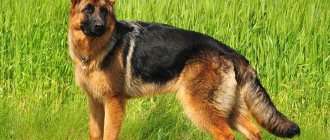Dobermans are large, strong dogs, and it makes sense that those considering bringing them into a home with small dogs might be more than a little concerned.
I've had personal experience with this, as well as talking to countless other Doberman owners about this situation, and there are a few things you need to know before trying to get a Doberman if you already have another dog.
Can Dobermans get along with other dogs?
A Doberman that has been well socialized from an early age will likely get along well with most dogs. However, problems can arise when the Doberman is not socialized enough or when both dogs are not neutered males.
If some basic steps are not taken, then there is certainly the potential for disaster when it comes to Doberman life especially with small breed dogs (Pomeranian, Shih Tzu, Pug, Miniature Pinscher, Toy Poodle, etc.).
Something as simple as a minor corrective paw strike, bite, or unexpected rollover of your Doberman can be literally deadly to a small dog, whereas if it were done to a similarly sized dog, it would be a minor incident at best.
Dobermans living with small breeds
Although Doberman Pinschers are generally kind dogs with a friendly demeanor, they can certainly have some challenges when living with a small breed of dog.
Most of these problems are not the result of purposeful actions by dogs, but are random in nature.
Yes, Doberman Pinschers can get along well with small dogs living in the same house as them. Dobermans are intelligent, gentle dogs that are easy to train and have a strong desire to please their owners. These are all attributes that can work greatly in your favor when you are trying to lead them to a successful relationship with another dog.
This is why so many Doberman owners have no problem having smaller, more fragile dog breeds living in the same home. You just need to give that guidance and make sure they know what is expected of them (i.e. Affectionate interaction with the other dog in the house).
So what's the difference between those who manage to have a Doberman and a small dog living in the same house and those who don't?
There are a few simple things you can do to make sure your Doberman gets along with your small dog that really have a huge impact on the outcome.
So after talking to countless owners who have both small dogs and Dobermans in the same home, I've narrowed down the best advice to the following most important tips.
TIP: If you are wondering how Dobermans are with cats, see my article Can Dobermans Get Along with Cats?. Even if you're dealing with a small dog, many of the tips in this article can help you understand what ideal pet-to-pet introductions look like.
Similar breeds
In appearance, but not in size, a breed similar to the Doberman is the German Doberman. It is believed that it was from this breed that Mr. Dobermann took an example for developing a new breed. In appearance it is closer to the American one, but the coloring is close to the European one. The German relative is medium in size, ideal for apartment living. There is also an even smaller breed - the miniature pinscher, or mini Doberman. This breed is absolutely identical to its brothers, and the main difference is only the size.
Reference . This breed, as well as the German Doberman and Miniature Pinscher, are very intelligent and easy to train. They are hunting dogs; with proper training, they can easily pick up a person’s scent and therefore often serve in law enforcement agencies.
Small dogs compatible with Doberman
There are many small dog breeds whose owners are quite successful living together in their home with their Doberman.
Please note that this is not a complete list. Many breeds not listed here are likely to get along well with the Doberman. This list was compiled by my own unscientific methods of communicating with Doberman owners who also have small dogs.
This list includes those with small breed dogs who were able to mate them in a home with a Doberman. Below are some breeds that I have found to have success with Dobermans in the past.
- miniature pinscher
- Border Terrier
- Pomeranian Spitz
- Jack Russell Terrier
- Dachshund
- Cocker Spaniel
- Chihuahua
- French Bulldog
- English bulldog
- Pug
- toy poodle
- Shih Tzu
- Beagle
Each dog has its own individual temperament, so it is more important to match temperaments than to select specific breeds.
Shepkita
A mix of Akita and German Shepherd, this is a large dog weighing 35-55 kg. An unusually intelligent creature, she is cunning and prone to dominance - it is important to let the dog know “who’s boss.” This is not to say that this is a family pet - the Shepkita does not like to be in contact with small children. However, he feels great with adults - he is a wonderful service animal.
Shepkita needs socialization and education. A strong, muscular dog requires long and active walks. Mestizos love to perform tasks - follow, catch, search.
Shepkita photo:
Tip #1: Get dogs of the opposite sex
Dogs of the opposite sex get along better in the world than dogs of the same sex. If you must have dogs of the same sex, try to get two females with a good age difference between them. It is usually much more difficult for two male dogs to get along.
The two males are likely to have trouble with their natural instincts to assert their dominance in the home. This probably won't be a problem for a puppy, but once that puppy grows up and starts having disagreements about food, you could have big problems.
Who is more picky about feeding?
Both the Doberman and the Shepherd feel great when receiving either balanced natural food or high-quality premium, super-premium or holistic food.
IMPORTANT!
When feeding natural food, the proportion of meat products should be no less than 50%.
In case of health problems, the dog should eat special dietary food.
Tip #2: Divide their ages by at least 2 years
It has been shown time and time again that dogs with age differences get along much better than dogs of the same age. If the age difference between your small dog and the Doberman is at least two years, then you have a good chance of them getting along.
Ideally, it is best for the small dog to be older and already settled into the home before the Doberman puppy is born. This is because Doberman puppies at an early age are much more likely to show playful curiosity towards another dog than they are to show any aggression.
So if your small dog is mature and your Doberman is immature (and physically small due to his young age), you will likely have a positive relationship between the two.
Just be especially careful at a time when the Doberman is just starting to grow in size, but is still a playful puppy at heart - a lot of injuries happen during this time.
Finally, a smaller, more mature dog will know when things get too tough and how to "stay away" from the larger dog.
If you have an adult Doberman and get a smaller breed puppy, they likely won't know when or how to get out of the way of the larger dog, and injuries will be much more likely.
Métis
The creation of mixed breeds did not bypass Dobermans. It is believed that mestizos, unlike purebred breeds, have better immunity to various diseases and are less susceptible to cold.
Rottweiler mix
A crossbreed between a Doberman and a Rottweiler has adopted the traits of both breeds in the same way; in general, these dogs are similar, especially as puppies. Well, having matured, he will turn into a surprisingly stately dog, with strong legs, stockier than a purebred representative of the breed. This mixed breed will have the classic color for both breeds - black with rusty tan.
And with his head he will look like a Rottweiler: the head is of medium size, with a well-defined occipital protuberance, the ears are set wide. The muzzle is slightly narrowed, ending in a wide lobe with widened round nostrils. The color of the ear lobes, lips and eye rims is black. The mestizo will take on the character of his parents and will be a brave dog.
Shepherd mix
A Doberman mixed breed with a Shepherd will make an excellent working breed. In appearance it will resemble a German Shepherd, black and red in color. The muzzle will be more pointed than that of a purebred Shepherd, but less than that of a Doberman.
The dog's height will be higher than that of a shepherd, and its body will be slender. If you do not train a mixed breed, he will become an irritable and dangerous dog, which will lead to unexpected behavior of the dog in different situations.
Pitbull mix
By crossing a pit bull and a Doberman, we get an irreplaceable guard, but also quite aggressive. After all, the pit bull is famous for its “death grip”, and the Doberman is not inferior to it in attacking the enemy. This mixed breed has strong paws and body, the color will vary from black to light rust with white tan . The muzzle will be oblong.
Mongrel cross
A dog with good immunity, smart, fast, an excellent protector and a good friend - this is all a cross between a Doberman and a mongrel. The appearance loses its aristocratic appearance, and the difference from the above mestizos is that this breed will not be short-haired. The description of this mestizo is rather vague, since everything depends on the mongrel, its size, and appearance. But most often they produce tall dogs with a strong body.
Other famous hybrids
Science knows the crossbreeds of a Doberman and a black Great Dane - a tall black dog that does not differ in appearance from a Doberman, but its color does not have tan and its height is slightly taller than a purebred dog.
The muzzle is elongated, the lower jaw is strong. And there is even baby Django, who is currently 3 years old.
This is a cross between a Doberman, Labrador and Boxer.
He has a brown color with light tan and blue eyes, which the dog took from a Labrador, since Dobermans are characterized by black eyes.
He has a stocky body, not very tall, about the size of a Labrador, strong paws and a strong jaw.
Tip #3: Spay males.
Neutered males are much more docile and have fewer pesky male hormones controlling their emotions. They will likely be less assertive in asserting dominance over your other dogs in the house, and fewer problems will arise as a result.
The younger the dogs are neutered, the better off you are. If you wait until your Doberman reaches adulthood (about 2 years old), then neutering will not be as effective in suppressing some of these natural dominant behaviors.
Which breed is best suited for indoors and outdoors?
Both of these dogs can be kept both in a private house and in a city apartment. But at the same time, you need to take into account that shedding is more pronounced in a shepherd dog.
Based on the amenities, we can say that a Doberman is more suitable for an apartment as a security guard..
The conditions of a private home, as a rule, require year-round keeping of a dog in the yard or in an enclosure. For Dobermans who do not tolerate cold well, this is hardly possible.
Therefore, the German Shepherd is more suitable for private households.
Expert opinion
Kozhevin Semyon Kirillovich
Expert dog handler.
“Both of these breeds do not require complex care. But you need to take into account that, unlike a shepherd dog, it will not be possible to keep a Doberman in the yard all year round. They are both unpretentious in feeding, unless they have allergies or other health problems. Caring for them does not involve cutting or trimming, which makes their maintenance much easier. But if a Doberman puppy’s ears are cropped, then he will have to take care of the surgical sutures for some time, and then put the ears in accordance with the standard.”
Tip #4: Keep Them Separated While Feeding
Statistically, most dog bites occur during or shortly before feeding. Dogs are wild animals at heart, and in the wild they must protect their food scraps from scavengers. This is why they naturally have the instinct to be more defensive and even aggressive towards other animals while feeding.
If, for example, your small dog gets too close to your Doberman when he is eating, it is not unlikely for the Doberman to scold the smaller dog with a nipper or worse. With a dog the same size as a Doberman, this won't be much of a problem. But for a small dog it could literally be deadly.
What are the similarities and differences
Similarities:
- Both breeds were bred in Germany and are used as service dogs or guard dogs.
- Both the Shepherd and the Doberman are very intelligent and quick-witted.
- Caring for both of them is easy.
- Both dogs are very trainable, although different methods are recommended.
- Both the shepherd and the Doberman are distinguished by their stately and harmonious build.
- Both breeds require serious training and a lot of physical activity.
- Representatives of both breeds are good with children and, with proper socialization, do not show aggression or bullying towards other animals.
Differences:
- The German Shepherd is considered a versatile dog, while the Doberman is best suited for detection, security, and bodyguard work.
- The German Shepherd's ears are naturally erect, while the Doberman's ears are cropped.
- A shepherd can have long hair, but a Doberman can only have short hair.
- The colors of the “German” are more varied than those of the Doberman Pinscher.
- The Shepherd feels good in a wide variety of climatic zones, but the use of the Doberman for work in regions with cold winters is difficult.
The German Shepherd is less excitable and not inclined to take offense or, especially, to take revenge on the owner for an insult.
Tip #5: Teach your Doberman the command “FU!”
Make sure your Doberman is well versed in the "ew" command before you try introducing him to a small dog. Doberman Pinschers are natural carnivores, especially small furry animals. This is why he may easily mistake your new Pomeranian or Chihuahua for something to chase and hunt.
So, having an established command that your Doberman has practiced and demonstrated mastery that will be a signal for him to get away from the dog can be a lifesaver.
During early encounters between two dogs, if your Doberman becomes too rough, you can quickly give him the command to "leave it" and hopefully be able to trust that he will shut down and go away.
Mixed Doberman and Old English Sheepdog
Dobski = Doberman Pinscher + Old English Sheepdog. Such a mixture of blood can be the most unexpected. To determine what a puppy will be like, you need to find all the characteristics of its ancestors. The baby can become any combination of these signs.
The average lifespan of a dobski is 10-12 years. The body weight of such mestizos is 30-40 kg.
Tip #6: Only allow play between the two when the small dog is older.
One of the biggest challenges when first introducing a small breed Doberman is that play time can be dangerous for a small dog. One paw to the back or one bite from a Doberman can cause serious injury or death. Additionally, often weighing around 50kg or so, a larger Doberman could accidentally roll over or otherwise accidentally crush a smaller dog.
Puppies do not have as much control over their movements and are not always able to recognize danger as easily as an older dog. This is why I suggest you only start allowing play between two dogs once the smaller one is an adult. An adult dog, even a smaller one, will be much easier to avoid trouble.
Some owners go further and don't even board a small dog with a Doberman until they are adults. This is certainly a cautious approach to solving this problem, but sometimes it is better to err on the side of caution.
Briefly about the German Shepherd
The German Shepherd does not need any special introduction: it is a dog that is familiar to all people from an early age. But still, comparing the shepherd dog with the Doberman, we should talk a little about it.
Description
A fairly large dog with a slightly elongated format.
Dimensions
range from 50 to 65 cm, and weight can be 30-50 kg .
The length of the muzzle and skull are approximately equal. When viewed from above, the German Shepherd's head resembles a tapering wedge. The ears are not too large, erect, in the shape of a triangle.
The neck is muscular and strong, the withers are pronounced, the back is slightly elongated and straight. The croup is sloping, turning into a saber-shaped tail. The forelimbs are parallel and even, the hind limbs are quite powerful and muscular.
The coat can be either short and harsh or quite long and softer.
Acceptable colors: black , gray of varying lightness, black and tan, saddleback , reddish .
The back and croup of the German Shepherd have a well-defined slope, due to which a silhouette with a sloping top line, characteristic of these dogs, is created.
Advantages and disadvantages
pros:
- Smart and easy to train dog.
- Very devoted and faithful.
- Loyal to children.
- Clearly understands where manifestations of aggression are appropriate and where they are not.
- Versatile: suitable for any service.
Minuses:
- She needs serious training and something she can do.
- Not suitable for the role of just a pet.
- If raised incorrectly, it can become aggressive.
- Hyperactivity occurs in some representatives of the breed, and some of the shepherd dogs, on the contrary, are characterized by a slow reaction.
- If the shepherd is overtrained, it may have a nervous breakdown.
The German Shepherd easily adapts to any climatic conditions, with the exception of arctic zones and regions with too hot climates.
Character
The German Shepherd is characterized by such traits as vigilance, attentiveness, obedience, distrust of strangers and the desire to please its owner.
Decisive, brave and moderately evil “Germans” can attack only on the orders of the owner.
She is calm and friendly with the owner and his family members. She treats children well, but prefers to communicate with adult family members who are involved in her upbringing and training.
The exceptional intelligence and intelligence of the German Shepherd make this dog a universal one, suitable for any service..
Tip #7: Introduce Them When They're Both Young
If you are unable to introduce the two dogs when the small dog is older and the Doberman is younger, then it is best to introduce them when they are both small puppies.
Being younger dogs, they are likely to be closer in size, which means there is less chance of accidental injuries occurring simply because one dog is much larger and heavier than the other.
Additionally, the two puppies will have a playful curiosity towards each other and most likely no aggression. This is the best option for introducing two dogs. So, by the time two dogs begin to emerge from puppyhood and enter adulthood, they have likely already formed a bond.
Shepherd Chow
German Shepherd and Chow Chow mixes are healthy puppies with an unusually cute appearance. Their weight varies - 12-43 kg. One of the features is the long fur of the Chow Chow, which tends to mat. This pet needs daily brushing and visits to the groomer for hair trimming.
Because of the same thick and dense fur, the Shepherd Chow does not feel well in an apartment - she feels great in an enclosure or kennel even in the cold winter. But this is not a watchdog, but a family pet - it was created not only to protect, but also to love people. Loves to communicate with his owners - especially with small children.
Photo of Shepherd Chow:
Tip #8: Keep your Doberman on a leash during initial interactions
Initially, it is always best to supervise interactions between your Doberman and any dog he is not familiar with. Close supervision is good, but you also need to be prepared to intervene if you start to see aggression in your dog or things get too rough.
One option is to keep the Doberman on a leash so that you can end the encounter very quickly by getting the larger of the two dogs out of the situation.
Things can get tricky here; Naturally, a dog will be more protected if it is on a leash than if it is off-leash. This is bad if you are introducing him to a new dog for the first time.
But in my opinion, it is more important that you have a very fast and reliable way to end the interaction if something goes wrong.
So, you will have to do your best to counteract any extra protectiveness your Doberman may feel towards you due to him being on a leash. For this it all depends on your attitude and behavior.
Be calm, happy, excited to see a new dog in the room. Bring a happy, positive attitude towards your new dog, and your Doberman will probably do the same. Praise your Doberman when he is careful around another dog. And use this leash to instantly separate them if you need to.
Attitude towards children and pets
The German Shepherd is calm and friendly towards children. He perceives older people as playmates, and treats children patronizingly.
A properly raised Doberman is also loyal to children, but he is less patient and restrained: he can snap if a child starts to annoy him or tease him too much.
Both dogs, when properly raised, do not show aggression towards other animals.
Tip #9: Separate them when you leave the house
Make sure that all interactions between the small dog and your Doberman are carefully supervised initially. Over time, as you begin to trust the relationship between them, you may begin to relax.
However, you can keep them separate if you're going away for much longer than you think you'll need. Many Doberman owners who have small dogs in the house keep them separated when they leave the house for indefinite periods of time (by placing each dog in a different room, or one dog in a crate and the other out of the crate, etc.).
Leaving them alone in the house while you're gone is the ultimate sign that you trust them. You should do this very slowly, or maybe not at all, depending on their relationship.
This is because you won't have the ability to intervene (or even know) if things get too rough or escalate too much. The last thing you want is to come home to an injured dog.
Who is stronger
To specifically answer the question: who is stronger than a Doberman or a German Shepherd, you need to compare specific dogs, and not breeds as a whole. Because everything will depend on what kind of physique and physical qualities this or that pet has.
It would seem that the Doberman is not small in size, it is taller and weighs more than the shepherd. However, if you do not exercise it and do not subject it to constant physical activity, a Doberman against a German Shepherd, which constantly walks and runs with the owner, performs various exercises, may turn out to be weaker and not be as hardy.
Therefore, it is difficult to answer this question objectively, based only on data about the breed.
In conclusion, we would like to add that before buying a dog of any breed, you should think carefully, read the information, and consult with dog handlers and amateur dog breeders. After all, a dog is a big responsibility and, like a child, it requires attention, love and care from its owner.
Tip #10: Provide a safe place for your small dog
Giving your small dog a chance to escape is incredibly important. If the situation escalates, your little dog will likely just want to get away from the overly excited 50-pound canine monster that is your Doberman. So never let two dogs get stuck together in a small place.
Try to create a place in the house where your small dog can walk, but the Doberman cannot follow him. A small dog house or other small shelter will do the trick.
Having this simple means of allowing your small dog to get some rest even when your Doberman wants to continue playing can make the interaction between them much more positive and fun.
Sugi
Shugi (nops) are funny crossbreeds of a German shepherd and a pug, a “product” of artificial insemination. They do not inherit their parent's breathing problems (due to the pug's flattened face).
The maximum weight of such a pet is 14 kg. This is a stocky animal with an easy-to-groom coat. Shugs are valued for their intelligence and energy, cheerful and friendly disposition. This is a family dog for a small apartment.
Photo of sludge:
Tip #11: Introduce a new dog only by smell.
A very effective approach with Dobermans is to first introduce them to the new dog by scent alone. Placing a Doberman on one side of the door and your Poodle, Shih Tzu, Giant Schnauzer or other small dog on the opposite side will allow them to become accustomed to each other's scent before they meet.
Once you've done this for a day or two, try putting your old T-shirts in each of their beds at night. The next night, change the shirt to the other dog's bed. This will further help them get used to each other's scent. This can make the initial in-person introduction much smoother later on.
Shepski
The German Laika, Shepsky, is a cross between a Siberian Husky and a German Shepherd. The weight of the animal is 15-40 kg. An unusual dog, similar to a wolf, it needs daily brushing and periodic washing of its coat with a dense undercoat. Like Huskies, Shepskis can have blue eyes and dyschromia.
This is an active animal that needs daily long walks, games and runs. Good as companions and working dogs. They are smart, friendly and loyal, and love children. Even a beginner can handle training such a dog.
Shepsky photo:
Tip #12: Introduction through the barrier
When it's time for two dogs to meet face to face for the first time, do so through some kind of barrier. A baby gate, kennel or chain link fence are all great barriers to use. This way they can interact with each other minimally, smell each other and see each other.
The best thing about this tactic is that it is a very safe way to introduce two dogs and will allow you to see how your Doberman reacts to a smaller dog without any fear or danger. If you see signs of aggression in your Doberman through the gate, it's time to slow down and delay introductions without barriers.
Other criteria
| Activity | Representatives of both breeds are very active, but German Shepherds, as a rule, are still somewhat calmer and not as active as Dobermans. |
| Distrust of strangers | The German Shepherd is a little more aggressive than the Doberman, but it only shows its viciousness when it receives the owner's permission. |
| Lifespan | Dobermans live somewhat longer: from 12 to 16 years, while the life expectancy of the “German” is 10-14 years. |
| Training | Representatives of both breeds are excellent at training. |
How to Determine Your Doberman's Aggression
When you first start introducing your Doberman to your new little furry friend, you will want to know what signs might indicate that your Doberman is protective and aggressive. Doberman Pinschers have several characteristic traits that you can look for.
- Tense Body Posture – The Doberman becomes noticeably stiff and stiff in his posture when he becomes excited. You will often see them standing in a wider stance than usual and they will be incredibly stiff with their eyes focused on their target.
- Back Hair – Small patches of hair between the shoulder blades or near the back of the dog may stand on end.
- Erect ears or tail. A tail (or "bump" if your dog has a docked tail) that stands straight and does not move is a sign of aggression, as are erect ears.
- Display of teeth. Showing their teeth by raising their lips is often done when they are about to show some level of aggression towards a person or animal. This is the first warning before a snap or bite.
- Growl - A deep growl or snarl while remaining focused on its target.
- Continuous Barking – Dobermans sometimes bark out of playfulness, but continuous deep barking with very little breaks in between is likely to be a much more serious bark that is a warning to the dog in question.
- Closing - Forcefully clicking on another dog is definitely a sign of aggression. Dobermans may click playfully at another dog (which is actually still very dangerous when directed at a smaller breed), but sharp clicking when the head is tilted to the side is a sign of serious aggression.
Some of these signs may be similar to Dobie's actions during normal play interactions, but if your dog is actually exhibiting aggressive behavior, they will likely show some of these signs. As their owner, you must be able to distinguish between play and real aggression.
If signs of aggression show up at any point while trying to introduce your Doberman to your new small breed dog, it's time to slow down or even take a step back.
For example, if you've just started dating face-to-face without barriers, it may be time to go back to creating a barrier between them.
If you've just started a cross-barrier meeting, it may be time to go back to smell-only introductions. Take your time introducing these two - one really bad experience between them could set the tone for the rest of their relationship.
A little about Dobermans
Doberman Pinschers are a breed developed at the end of the 19th century in Germany and were originally intended mainly for detective work in the police, as well as as a bodyguard.
Description
The dog is medium or large in size , height for males is from 68 to 72 cm, for females - 63-68 cm, weight is from 32 to 45 kg . The body is square format. The bones are quite strong, but not massive or rough, the muscles are well developed.
The head is wedge-shaped, the length of the muzzle is approximately equal to the length of the skull. The neck is graceful, but quite strong and muscular. The withers are pronounced, the back is quite wide and strong.
The chest is strong and moderately wide, reaching the elbow joints. Limbs are straight, parallel, well muscled.
The coat is short, smooth, shiny and quite hard. The color is black or brown and tan.
Dobermans' tails and ears are traditionally cropped , while in most countries this operation is prohibited .
See what an undocked Doberman looks like here.
Advantages and disadvantages
pros:
- He is friendly and does not show aggression without reason.
- Treats children well.
- As a rule, he gets along with other pets.
- Calm and balanced.
- Well trained.
- Beautiful and effective in appearance.
Minuses:
- The protective instinct and territoriality are too developed.
- Not every person can be its master, but only a leader by nature.
- With a lack of upbringing, he can become self-willed, stubborn and disobedient.
- Tends to act out when the owners leave the house: often, out of boredom, he damages furniture or other things.
- He is very sensitive and does not tolerate rough handling.
- Touchy.
It should be remembered that dogs of unknown origin may have an unbalanced psyche, so a Doberman should only be purchased with documents.
Character
The Doberman is not inclined to show aggression unless there are significant reasons for it. This is a calm animal that knows its worth, which in a home environment becomes affectionate and friendly.
Has great energy and mobility.
If the Doberman is not provided with the physical activity it needs and does not devote time or attention to training, the dog may become uncontrollable.
The Doberman cannot tolerate rough treatment, and remembers undeserved insults for a very long time..
Read more about the character of Dobermans here.

